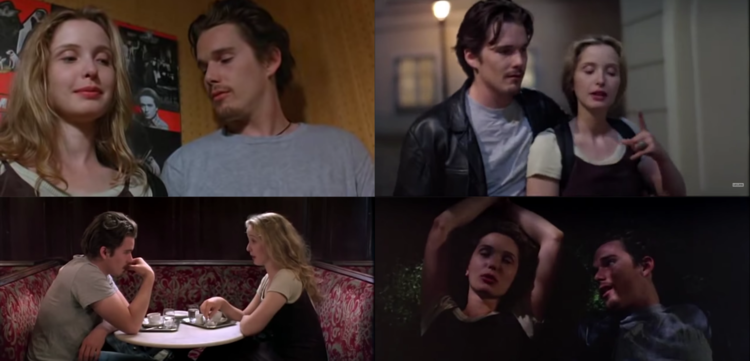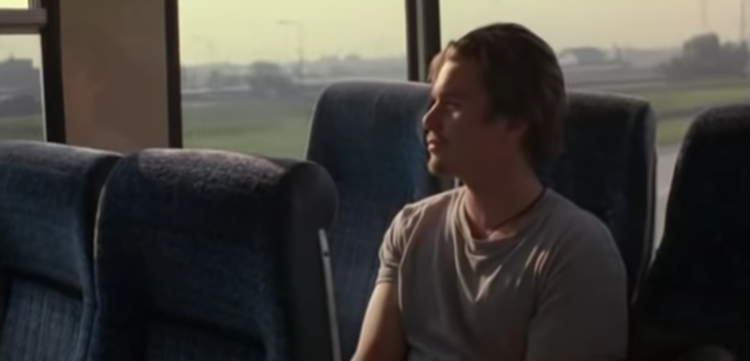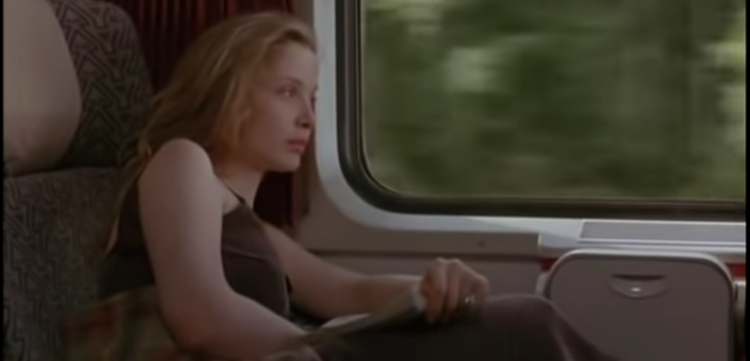How naturalism elevates the romance of 'Before Sunrise'

Julie Delpy and Ethan Hawke begin a romance for the cinematic ages in 1995’s “Before Sunrise.” (Columbia Pictures/MovieStillsDB.com)
Every week, Ultimate Movie Year looks back into the past to highlight the best film that came out that weekend.
“Before Sunrise”
Released January 27, 1995
Directed by Richard Linklater
A couple is arguing on a train. Annoyed by the distraction, Celine (Julie Delpy) gets up to sit in another part of the train. Across the aisle from her is Jesse (Ethan Hawke), and the two strike up a conversation. It’s a chance encounter that leads to the most romantic night of their lives.
“Before Sunrise,” the 1995 film directed by Richard Linklater, could have easily not worked, and it probably shouldn’t have. The movie is about two young adults who meet on a train en route to Vienna, and agree to get off together to spend the night wandering around the city with each other. When the morning comes, they’ll both resume their travel to their respective destinations. Suddenly, their “happily ever after” conclusion doesn’t seem pre-destined.
Linklater was coming off his third feature film, 1993’s “Dazed and Confused,” which featured many upcoming young stars and went on to become a cult comedy. “Dazed” took place over one day, as does “Before Sunrise” and its sequels. Working with a specific period of time, and how we spend it, is clearly a preoccupation for the director. With his 2014 “Boyhood” film, Linklater would go on to document a young child growing up over 13 years. It’s an exciting and unique approach to focus on both the highlights and the moments in-between them. In “Before Sunrise,” Jesse even speaks with the voice of the director for a moment, as he shares with Celine his idea for a documentary series that would follow 365 people for one day each.
What’s engaging about “Before Sunrise” is that once Jesse and Celine decide to leave the train, they are together for almost the entirety of the film. That doesn’t just mean in story, but in how Linklater chooses to document their travels and discussions, as they are consistently framed together in the same shot. This makes “Before Sunrise” very unique in films, as many conversations between characters are often documented in shot reverse shot, with the camera recording one side of the conversation (sometimes over the shoulder of the listener, slightly in frame from behind), then cutting to the other person. This is common not just in romance pictures, but in movies in general.
Instead of using those conventional techniques, Linklater finds a way to shoot scenes between Jesse and Celine where we can see both of their faces during the conversation, whether they are sitting on a bus, walking down a street, or lounging around one of the city’s monuments. This creates an effect on the audience, as we are subconsciously trained to always want to see them together instead of in individual shots, but also, allows Linklater to have long takes between the characters with minimal editing. It gives us more of a sense of being there on the streets of Vienna with Jesse and Celine as an invisible observer, without the traditional cinematography and editing structure to remind us that we are watching a movie.
The technique helps the ending resonate with us more after they depart back into “real time” and resume their travels. Jesse and Celine are heading in separate directions, but as they each sit across from empty seats, we can sense the absence of their lover, as they no longer share the screen together.
Although the production was initiated with a script from Linklater and Kim Krizan, Delpy and Hawke reportedly had their own input into the screenplay once they were cast. However, they didn’t receive an onscreen credit for it. This collaboration allowed the actors to invest, engage, and connect even further into their characters, developing a rhythm that contributed to their natural chemistry together. This, combined with Linklater’s direction, brought authenticity and dimension to the film that avoided contrivance. Even as we listen to the conversations between Celine and Jesse, there are times when it can meander away from furthering the plot or their relationship, and into philosophical thoughts about life, love, death, and memory. There’s a lack of structure here, and more of a focus on finding the truth on what would happen if you just had two strangers talking to each other all night without it sounding like a three-act screenplay. It even subverts the traditional third act in a romance, when the lovers are separated for some reason in countless other films, and instead have Celine and Jesse talk about how they’re trying to fend off their upcoming separation.
But it is within those moments when Celine and Jesse chat about whatever crosses their mind, where we learn more about their characters. As the partner who initially proposed the wild idea of departing the train to pause their travels for the night, Jesse is sweet, adventurous, and attentive. During the movie, we also learn that he is coming off a recent heartbreak, and is slightly contemptuous of people who ask for money (even when they are given something in return). Just before “Before Sunrise,” Hawke played the volatile Troy in Ben Stiller’s “Reality Bites,” as the 1994 film had come to be anointed as the defining film account of Generation X. For his part, Troy became every bit the sarcastic slacker archetype as the jock, rebel, crazy, queen, and nerd roles in “The Breakfast Club” a decade before. Jesse is less a character in a movie than a fully-fleshed out person in “Before Sunrise,” a young man interested in a woman who’s trying to be naturally charming, but occasionally allows his negative traits to reveal themselves.
Meanwhile, Delpy, a French actress, was being noticed in foreign films and American independent pictures, most notably “White,” the middle installment of Krzysztof Kieslowski’s Three Colors trilogy where she played a recently divorced woman who remains the object of obsession of her ex-husband. In “Before Sunrise,” Delpy’s Celine is open, kind, and possesses slightly more maturity than Jesse. Both Delpy and Hawke capture a common element among young adults, where they are ruled by idealism and romanticism before the curse of aging weighs them down with cynicism, responsibility, and reality. It’s a romantic film that plays well for the young and offers additional layers as us viewers age as well.
Upon release, “Before Sunrise” received praise from critics and earned more than double its small budget during a limited run at the box office. It didn’t receive any attention during awards season, and perhaps as the years went on, it could have faded from the memories of filmgoers, blending together with the numerous small indy films released during that era. However, Linklater, Hawke, and Delpy came together to write and film the 2004 sequel “Before Sunset,” which reunites Jesse and Celine nine years after their first meeting. Similar in structure and tone, the two share memories of their night together, and what has happened since then. Nine years after that, the team produced a third film, “Before Midnight,” which sees the couple grapple with a long-term relationship. Now a trilogy, all of the Before films won acclaim and allow the creators to continue building upon their work while keeping the movies in the zeitgeist and finding new audiences to discover the 1995 original.
“Before Sunrise” was released during a time when American audiences were embracing more independent films. Linklater is part of that generation of filmmakers who made their bones during that decade, and he’s mixed passion projects with more mainstream work over the years. From this vantage point in history, his influential work remains in those slice of life projects like “Dazed and Confused,” “Boyhood,” and the Before trilogy. Whether he’s documenting 13 years or one day, few are better at capturing naturalism in film than Linklater.
The Weekend: The regular release schedule begins to really diversify at this point, as there isn’t any one type of film or genre that dominates the calendar historically, but instead several kinds of movies. Among the notable releases include the 1931 premiere of “Cimarron,” one of the first films to win top honors at the Academy Awards, debuted in New York City. John Ford’s adaptation of “The Grapes of Wrath” premiered in 1940, Robert Altman’s “MASH” was released in 1970, and martial arts superstar Donnie Yen returned for “IP Man 2,” which made its debut in the United States in 2011.
Several thrillers also launched here over the years: “Eye of the Beholder” in 2000, “Darkness Falls” in 2003, “The Butterfly Effect” in 2004, “Hide and Seek” in 2005, “The Rite” in 2011, and “The Grey” in 2012.
January is often known as a dumping ground for films as well, as studios unleash their worst movies on audiences to minimize their risks. This weekend seems like a particularly potent one on the calendar, as the following critically demolished and financial bombs dropped on an unsuspecting fourth week in January: “Epic Movie” in 2007, “The Hottie and the Nottie” and “Meet the Spartans” in 2008, “Movie 43” in 2013, “Mortdecai” in 2015, and “Serenity” in 2019. I’ve never seen any of these movies, but by every account I’ve ever read, may God have mercy on your souls if you have.
At the peak of the popularity of pop music group the Spice Girls, 1998 also saw the release of “Spice World,” which some might list in the films above, but not me: It’s just subversive enough to be allowed.
With Valentine’s Day on the horizon, audiences are starting to see more movies about romance open to position themselves for one of the most significant date nights of the year. Preston Sturges directed the 1941 comedy “Sullivan’s Travels” which featured a young Veronica Lake. Jennifer Lopez and Matthew McConaughey starred in the 2001 romantic comedy “The Wedding Planner,” while Mandy Moore headlined the Nicolas Sparks adaptation, “A Walk to Remember” in 2002. All things considered, it makes sense to go with “Before Sunrise” as the film releases begin to focus on love, a theme we’ll continue next week with a foreign entry from 2000.
Next Week: “In the Mood for Love”
Follow me on Facebook, Twitter, and Instagram to find out when new columns are released, or to just chat up movies.
Mark is a longtime communications media and marketing professional, and pop culture obsessive.







